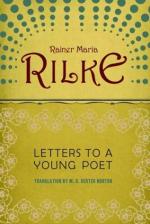|
This section contains 758 words (approx. 2 pages at 400 words per page) |

|
Letters to a Young Poet Summary & Study Guide Description
Letters to a Young Poet Summary & Study Guide includes comprehensive information and analysis to help you understand the book. This study guide contains the following sections:
This detailed literature summary also contains Topics for Discussion and a Free Quiz on Letters to a Young Poet by Rainer Maria Rilke.
This book consists of ten letters, written by famed poet Rainer Maria Rilke, to a Young Poet who initially sought him out for writing advice, but ended up learning a great deal about life. The letters encourage the Young Poet to develop an understanding of, and connection, to his inner creative soul. In doing so, Rilke explores themes relating to the necessity of solitude, the relationships between creativity, nature and sexuality, and the importance of living a full life. Over the years the book (originally published by the Young Poet to whom the Letters were originally written) has come to be seen as a kind of guide to life, not just for artists and other creative individuals but for anyone determined to get in touch with her own humanity.
The first of Rainer Maria Rilke's Letters to a Young Poet is evidently a response to a letter written to Rilke by the Young Poet. Rilke thanks the Young Poet politely for sending him his work for criticism, commenting briefly but gently that the work is, for the most part, immature and underdeveloped. He then begins a series of discussions, continued throughout the Letters, of how both the Young Poet and his work can become more mature, more richly developed, and ultimately more connected to the Young Poet's creative soul.
This last point is Rilke's main concern, explored throughout the letters via several key themes. The first theme is Rilke's insistence that solitude, and contemplation within the context of that solitude, is essential if the Young Poet (and, by extension and implication, any artist) is to create work of both universal truth and lasting value. A second of Rilke's important themes, again developed throughout several of the letters, is that creativity is inextricably linked to nature, which he in fact suggests is the ultimate manifestation of creativity—all nature, he suggests, is an act of creation. Rilke's third key theme, perhaps a surprising one, is that sexual expression and experience of sexual feeling is both a manifestation of the creative spirit and an expression of humanity's nature. Rilke's fourth key theme is the importance of love and connection between individuals, an experience absolutely essential for the Young Poet (and again, by extension all artists) if he is to come to both an understanding of himself and nature. Throughout the book, Rilke contends that once an experience or understanding of these aspects of human life have been absorbed, only then is true, transcendent art possible.
Rilke's final thematic point is that a deepening understanding of life and its meanings is only possible if it is truly lived. He repeatedly suggests that the Young Poet must both engage fully in everything he experiences (his non-writing career, his relationships, his sexual desires, his writing) as well as contemplate them in solitude. The letters demonstrate this theme in more ways than simply their content. For example, the fact that they are written from several different locations in Europe—France, Italy, Germany, Sweden—offers the very clear sense that Rilke, while restless and frequently ill, is out in the world seeing new places, living new experiences, and integrating new perceptions and understandings of humanity into his creative spirit and life. There is also the sense Rilke is writing from a very personal, intimate perspective. Letter 8 in particular carries with it the very powerful implication that Rilke is writing about both pain and comfort from a place of experience, contemplation and understanding.
The Letters contain no specific descriptions of the Young Poet, very few descriptions of his work, no examples of his work, and above all none of his letters to Rilke. Everything the reader comes to understand about the Young Poet must be gleaned from hints in Rilke's writing. Nevertheless, the book gives the impression the Young Poet undergoes a journey of transformation over the course of his correspondence with Rilke. It seems that in his first letter, the Young Poet is insecure and lacks connection with his own genuine, unique creative impulse. Over the course of the letters he struggles to connect with that impulse, trying the techniques Rilke suggests. By the conclusion of the book, Rilke seems to indicate the Young Poet has come to a place of completion and accomplishment, has connected with his creative voice and written a poem Rilke says is undeniably his own. The implication, as the letters draw to a close, is that while this stage of the Young Poet's development is ending, his true creative journey is just beginning.
Read more from the Study Guide
|
This section contains 758 words (approx. 2 pages at 400 words per page) |

|



